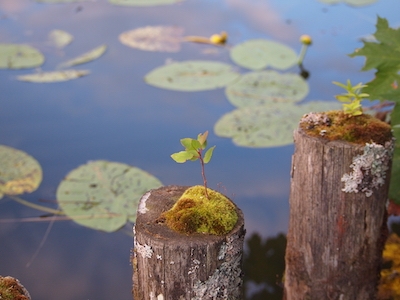Grow like a plant – Tai Chi Aspects
Who does not dream of gentle, effortless movements in the form? Let’s take a close look at nature to create more gentleness in our movements: Plants grow slowly, constantly, determined – even through walls, concrete and asphalt.
How does such a strong, but gentle movement develop?
A plant grows
Let’s take a look at how a plant grows out of a seed:
- The seed drops down into the ground and starts to sprout. – This takes TIME.
- The seed in the earth has to be kept moist. – The plant needs WATER.
- The plant develops its roots first. – It grows a connection to the GROUND, which constantly continues growing.
- Now the seedling becomes visible above ground. The plant reproduces the characteristic shape that is memorised in its DNA.
- However, the plant is not a simple copy. It is UNIQUE: its growth and appearance is adapted to its surroundings.
What can we learn form this for our practice?
- Meditation: Gently growing into the shapes of the form
- Doing the form, we grow into the final shape of each movement like a plant. Nils’ video shows how you can integrate this Tai Chi Aspect into the single movements of the form.
Gentle movements – 5 tips to learn to grow like a plant

Take your TIME
Do the form a few times extremely slow and listen inside.
- What settles, what releases?
- How much can I exhale, if I allow myself enough time?
- How deep can I inhale, calmly, without forcing it?
Tranquility breeds (gentle) strength.
Accentuate the FLOW
We should always be upright, we always want to be centred, the movements of the form should be exact. All agreed! But that is not the whole picture: upright AND fluffy, centred AND agile, exact AND flowing. To promote gentle movement, do the form a few times prioritising the flow. – Move freely, like a torrent.
Keep your contact to the GROUND
A flowing movement is wonderful, almost like dancing… But we do. Not want to be carried away by the water.
Do the form for a few times and concentrate on your connection to the ground. Each time we go into a posture and during the whole process of the form, our waist height should be the same.
Watch yourself:
- Do you move upwards from the legs? – This could be a sign for too much activation.
- Do you collapse downwards? – This could be a sign for too much relaxation in the base.
- You are light like a feather and everything feels effortless ? – Check, whether there is any change at all in the feet or any distinct contact to the ground, which may be felt as a pressure in the sense of muscle compression.
(You may want to check out the Tai Chi Aspects Grounding/Continue Grounding, Digging, Rewinding).
Memorise the SHAPES OF THE FORM of the form deep down in your brain
The plant uses its DNA to get into its programmed shape. Our shapes are the postures and movements of the form.
Do the form and rewind a few times before each posture. At first, rewind just a tiny bit, later rewind so far as you need to move your foot out and in again. (See the video for the Tai Chi Aspect: rewind here).
This method takes to getting used to, but it is a good hack to support your brain with adding the postures to its neuromotoric memory. When you required some effortlessness in rewinding, you will never experience your mind’s rummaging around in your head searching for the next posture. They will have become part of your Tai Chi DNA.
Make YOUR moves
Just go into the starting position and do the form as you are able to do it in this moment: follow your feeling – without principles and rules for body posture. How does it feel?
In the ideal case, our upper body remains unchanged during the course of the form: straight spine, upright – but at the same time released – rib cage, a head held as if floating – linke in seated meditation.
For most of us, this is not a natural posture. Our daily posture usually differs a lot from this ideal. And there are (good) reasons for that: our daily work, our way of life – the environment, in which we live. Tai Chi is a way to cultivate a second – healthier – nature. For this way, it is not helpful to forcibly break open protective and defensive postures, which our bodies in some cases developed over decades.
Concepts like „hanging from heaven“/„being suspended from above“ – to keep the head up straight – or the instruction to tuck in the tailbone – to move Huiyin to its „ideal“ position – are generally paid with an unnecessary stiffness (too much „yang“) or emptiness (not enough „yin“) of movement. The wish to accelerate the gradual reorganisation of our body by e.g. stretching our spine, leads to artificial movements, which are not related to our body in its present state. We only press the plant into a form, which is neither suitable for itself, nor for the environment in which it grows. Under these circumstances, gentle growth is not possible.
Joyful practice, perseverance and patience, not vehemence and adherence to principles are the foundations for a gentle growth of your form.
Have fun experimenting!
Profile: Tai Chi Aspect – Grow like a plant
- Difficulty: easy
- Goal: Developing gentle movements
- Method: observation of nature, self-observation
- Element: wood
- Related Tai Chi Aspects: Grounding/Continue Grounding, Digging, Rewinding
Check our Youtube-Channel for more Tai Chi Aspects!
Video Grow like a plant – Tai Chi Aspects
- Always move “just enough” (passive stepping)

- Tai Chi stepping 9/10 – Always leave the line of attack

- Tai Chi stepping 8/10 – Match your steps

- Tai Chi stepping 7/10

- Tai Chi stepping 6/10

- Tai Chi stepping 5/10 – Watch your back

- Tai Chi stepping Rule 4 – Keep connected to the ground

- Tai Chi stepping rule 3

- Tai Chi stepping rule 2

- Tai Chi stepping rules

- PLAY TAI CHI – Tai Chi Aspects

- Fast Forward – Tai Chi Aspects


















